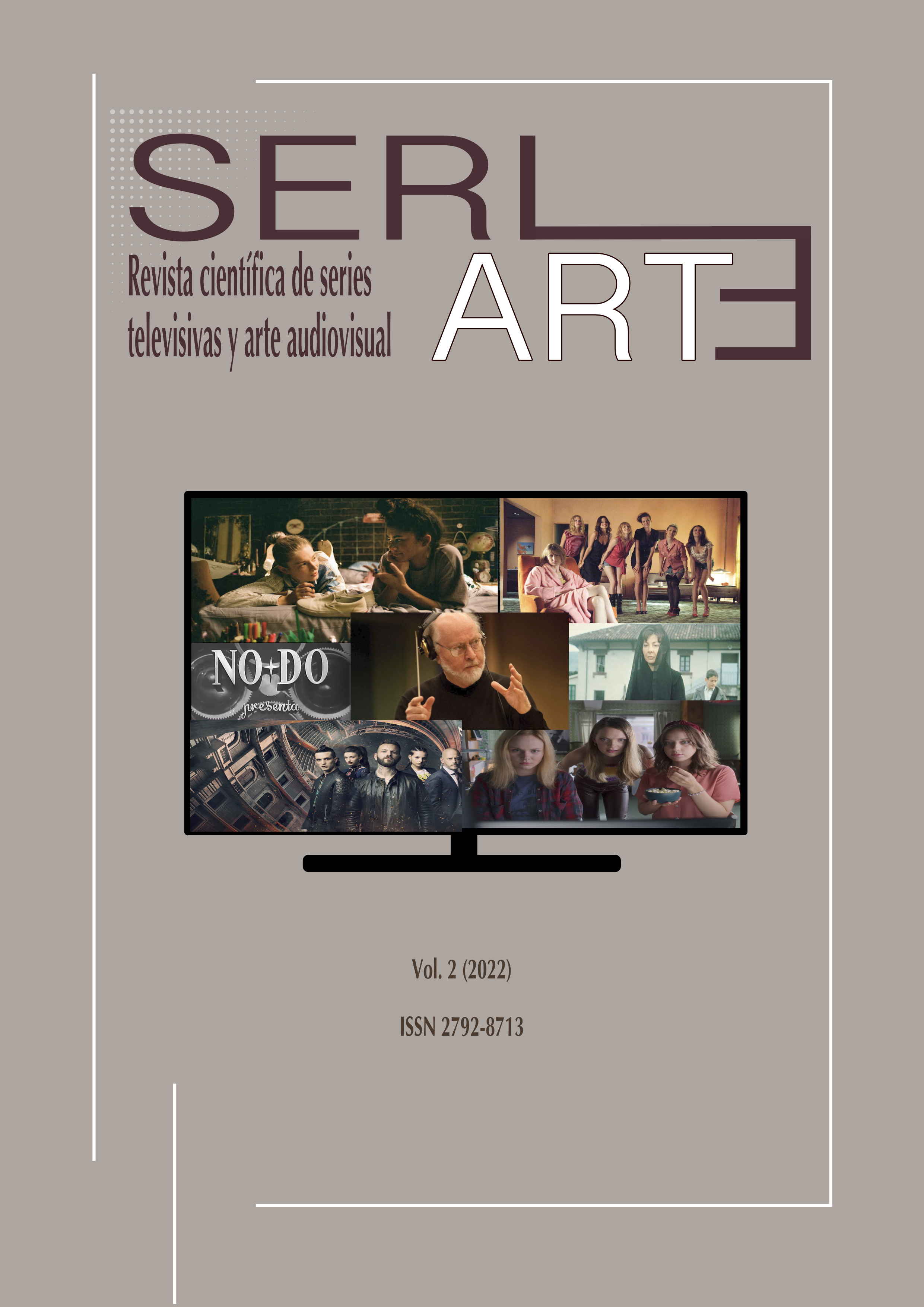SUBURRA – LA SERIE AS A RESULT OF A TRANSMEDIAL PROCESS
Main Article Content
Abstract
Suburra – La serie (2017 – 2020) is a production inspired by the novel of the same name (2013), which was published by Giancarlo De Cataldo and Carlo Bonini. Most of the studies carried out on serial production are either thematic or include them in general studies, where Suburra is one more example. For this reason, the objective of our study is to analyze the novel-TV series binomial as a result of a transmedia rewriting. To limit the analysis, we focus on the literary characteristics and the transmedia phenomenon that promotes the deployment of a story in two different media. Thus, we obtain as a result that the literary qualities are reformulated to the television format, which is nourished by the literary and cinematographic language.
Downloads
Publication Facts
Reviewer profiles N/A
Author statements
Indexed in
- Publisher
- Ucopress. Cordoba University Press
Article Details
References
ARIETE, Valentina (2017), «Suburra: L’anello di congiunzione tra Romanzo criminale e Gomorra». En: <https://movieplayer.it/articoli/suburra-la-recensione-della-nuova-serie-netflix_17890/> (Fecha de consulta: 24/03/2022).
BANDIRALI, Luca y TERRONE, Enrico (2012), Filosofia delle se¬rie tv. Dalla scena del crimine al trono di spade, Milano: Mimesis.
BENVENUTI, Giuliana (2020), «Transmedia storytelling all’italiana: da Romanzo Criminale a Suburra», en Sara MARTIN; Isotta PIAZZA (eds.), Spazio mediale e morfologia della narrazione, Firenze: Franco Cesati, pp. 129 – 143.
BONINI, Carlo y DE CATALDO, Giancarlo (2017 [2013]), Suburra, Turín: Giulio Einaudi Editore.
CAPRARA, Giovanni (2012), La novela policíaca en Italia, Sevilla: Ediciones Alfar.
CARDINI, Daniela (2016), «Serial Contradictions. The Italian Debate on Tv Series», Series - International Journal of TV Serial Narratives, vol. 2, nº 1, 47–54. DOI: https://doi.org/10.6092/issn.2421-454X/6163
CERDEÑO, Mario (2017), «‘Suburra’: no hay cosa peor que una marca blanca». En: <https://www.eldiario.es/castilla-la-mancha/los-lunes-seriefilos/suburra-cosa-peor-marca-blanca_132_3055025.html> (Fecha de consulta: 24/03/2022).
CUADRADO ALVARADO, Alfonso (2013), «Cronotipos de ficción seriada televisiva: las relaciones entre acción, personaje y tiempo», en GÓMEZ MARTÍNEZ, Pedro (coord.), Teorías y aplicaciones narrativas, Madrid: Icono14 Editorial, 237-259.
GENETTE, Gérard (1989), Figuras III, Barcelona: Lumen.
JENKINS, Henry (2003), «Transmedia Storytelling». En: <https://www.technologyreview.com/2003/01/15/234540/transmedia-storytelling/> (Fecha de consulta: 24/02/2022).
JENKINS Henry (2006), Convergence Culture: Where Old and New Media Collide, New York: New York University Press.
JENKINS Henry (2007), «Transmedia Storytelling 101». En: <http://henryjenkins.org/2007/03/transmedia_storytelling_101.html> (Fecha de consulta: 24/02/2022).
JENKINS Henry (2011), «Transmedia 202: Further Reflections». En: <http://henryjenkins.org/blog/2011/08/defining_transmedia_further_re.html?rq=defining%20transmedia>(Fecha de consulta: 24/02/2022).
MILLS, Brett (2013), «What does it mean to call television ‘cinematic’?», en JACOBS, Jason; PEACOCK, Steven (eds.), Television Aesthetics and Style, New-York-London: Bloomsbury, pp. 57-66. DOI: http://dx.doi.org/10.5040/9781628928327.ch-003
MITTELL, Jason (2009), «Lost in a Great Story: Evaluation in Narrative Television (and Television Studies)», en PEARSON, Roberta (ed.), Reading Lost: Perspectives on a Hit Television Show, London-New York: I.B. Tauris, pp. 119–138. DOI: http://dx.doi.org/10.5040/9780755697137.ch-007
MACEDO DE CARVALHO, Ludmila Moreira (2013), «The qualities of complexity: Vast versus dense seriality in contemporary television», en JACOBS Jason; PEACOCK Steven (eds.), Television Aesthetics and Style, New-York-London: Bloomsbury, pp. 45-56. DOI: http://dx.doi.org/10.5040/9781628928327.ch-002
NGUYEN, Hanh (2017), «‘Suburra’ Review: Netflix’s Italian Answer to ‘Narcos’ Is a Stylish Mix of Violence, the Vatican, and at Least One Orgy». En: <https://www.indiewire.com/2017/10/netflix-suburra-review-italian-narcos-sex-violence-religion-orgy-1201884389/> (Fecha de consulta: 24/02/2022).
Q. F. (2020), «Mondo di mezzo, ecco perché per la Cassazione Buzzi e Carminati sono “criminali semplici”: “A Roma funzionari assoggettati e collusione sistemica. Forme di corruzione sistematica ma non c’era mafia”». En: <https://www.ilfattoquotidiano.it/2020/06/12/mondo-di-mezzo-ecco-perche-per-la-cassazione-buzzi-e-carminati-sono-criminali-semplici-a-roma-funzionari-assoggettati-e-collusione-sistemica-forme-di-corruzione-sistematica-ma-non-cera-mafi/5832742/>(Fecha de consulta: 24/08/2021).
RENGA, Dana (2018), «Suburra. La serie as “Patrimonio Internazionale / International Patrimony”», International Journal of Tv Serial Narratives, vol. 4, nº1, pp. 65-80. DOI: https://doi.org/10.6092/issn.2421-454X/7815
RUSSO, Paolo (2018), « (The Facts Before) The Fiction Before the Facts: Suburra from Novel (to Trial) to Feature to TV Serial», en THORNLEY, Davinia (ed.), True Event Adaptation, Londres: Palgrave, pp. 111–141.
SANTANDREA, Matteo (2019), È stata Roma. La criminalità capitolina dal “poliziottesco” a Suburra, Roma: Rubbettino.
SCARPA, Vittoria (2015), «Stefano Sollima. Regista. Il racconto di genere è come una favola: sempre attuale», En: <https://cineuropa.org/it/interview/300079/> (Fecha de consulta: 8/12/2021).
SCOLARI, Carlos (2011), «Narrativas transmediáticas y adaptaciones: el caso Tintin». En: <https://hipermediaciones.com/2011/11/10/narrativa-transmediatica-y-adaptaciones-el-caso-tintin/> (Fecha de consulta: 24/02/2022).
THOMPSON, Kristin (2003), Storytelling in Film and Television, Cambridge: Harvard University Press.
VALLES CALATRAVA, José Rafael (1991), La novela criminal española, Granada: Universidad de Granada.
MING, Wu (2009), New Italian Epic. Letteratura, sguardo obliquo, ritorno al futuro, Turín: Giulio Einaudi Editore.
ZAVALA, Lauro (1999), La precisión de la incertidumbre. Posmodernidad, vida cotidiana y escritura, Ciudad de México: Universidad Nacional Autónoma de México.






